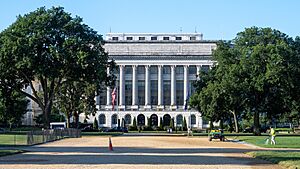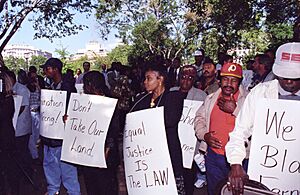United States Department of Agriculture facts for kids

Seal of the USDA
|
|

Logo of the USDA
|
|
 Flag of the USDA |
|
| Agency overview | |
|---|---|
| Formed | May 15, 1862 Cabinet status: February 15, 1889 |
| Preceding agency |
|
| Jurisdiction | Federal government of the United States |
| Headquarters | Jamie L. Whitten Building 1301 Independence Avenue, S.W., Washington, D.C. 38°53′17″N 77°1′48″W / 38.88806°N 77.03000°W |
| Employees | 105,778 |
| Annual budget | US$213 billion (2024) |
| Agency executives |
|
The United States Department of Agriculture (USDA) is a part of the U.S. government. Its main goal is to help with farming and food production. It also works to make sure our food is safe to eat. The USDA protects natural resources and helps communities in rural areas. A big part of its job is to fight hunger in the U.S. and around the world.
The person in charge of the USDA is called the secretary of agriculture. This person reports directly to the president of the United States. The current secretary is Brooke Rollins, who started in February 2025.

A large part of the USDA's budget, about 71%, goes to programs that help people get healthy food. These programs are managed by the Food and Nutrition Service (FNS). The biggest program is the Supplemental Nutrition Assistance Program, which used to be called 'Food Stamps'. This program is very important for helping people get the food they need. The United States Forest Service is also a big part of the USDA. It manages national forests and grasslands, which make up about a quarter of all federal lands.
Contents
What the USDA Does
The USDA is organized into different areas, each focusing on a specific part of its mission. Here are some of the main things the USDA does:
Helping Farmers and Protecting Resources
- Farm Production and Conservation: This group helps farmers with their crops and land. They offer support and advice to make farming easier and more sustainable.
- Natural Resources and the Environment: This area includes the Forest Service. They work to protect our forests, grasslands, and other natural resources. This helps keep our environment healthy for everyone.
Making Sure Food is Safe and Healthy
- Food, Nutrition, and Consumer Services: The Food and Nutrition Service (FNS) is part of this group. They run programs like the Supplemental Nutrition Assistance Program. This program helps over 40 million people get healthy food each month. They also teach people about good nutrition.
- Food Safety: The Food Safety and Inspection Service (FSIS) makes sure that meat, poultry, and egg products are safe to eat. They check that these foods are healthy and correctly labeled.
Supporting Agriculture and Research
- Marketing and Regulatory Programs: These programs help farmers sell their crops and food. They also work to prevent diseases in animals and plants.
- Research, Education, and Economics: This group does important research to improve farming. They study new ways to grow food and protect crops. They also collect information about agriculture to help farmers and the government make good decisions.
- Rural Development: This area helps rural communities grow and thrive. They provide support for housing, businesses, and important services like water and electricity in the countryside.
- Trade and Foreign Agriculture Affairs: This group helps American farmers sell their products to other countries. They also work on programs that send food aid to developing countries.
History of the USDA
The idea for the USDA started a long time ago when the American economy was mostly based on farming. People in the government wanted to find new and better seeds, plants, and animals for the country.
Early Beginnings
In 1837, Henry Leavitt Ellsworth started collecting and sharing new seeds and plants. He did this through members of Congress and local farming groups. In 1839, Congress set up the Agricultural Division within the Patent Office. They gave it money to collect farming information and for other agricultural purposes. Ellsworth is sometimes called the "Father of the Department of Agriculture" because of his efforts.
Becoming a Department
On May 15, 1862, Abraham Lincoln created the independent Department of Agriculture. It was led by a commissioner and had only eight employees. Lincoln called it the "people's department" because so many Americans were involved in farming. The department's job was to research and develop agriculture, rural areas, and human nutrition. Isaac Newton was the first commissioner.

In 1889, the Department of Agriculture became a Cabinet-level department. This meant its leader, the Secretary of Agriculture, became a direct advisor to the President. This showed how important farming was to the country.
The USDA also started working directly with farmers in every state. Laws like the Hatch Act of 1887 helped fund agricultural experiment stations in each state. The Smith-Lever Act of 1914 then funded programs to teach farming and home economics to the public.
Modern Times
During the Great Depression in the 1930s, many people returned to farming. The USDA helped make sure food was still produced and given to those who needed it. It also offered loans and advice to farmers. The USDA's Bureau of Home Economics even published recipes to help families make their food last longer.
More recently, the USDA has continued to support farmers. In August 2018, it provided a $4.7 billion aid package to American farmers. In February 2022, the USDA started a $1 billion program called Partnerships for Climate-Smart Commodities. This program tests and checks farming methods that are good for the climate. In October 2022, the USDA announced a $1.3 billion program to help farmers who were behind on loan payments.
In February 2025, the USDA made some changes to its staff. It later clarified that some employees who worked on highly dangerous avian influenza were let go by mistake and that the USDA was working to fix this. In March 2025, the USDA also changed two federal programs that helped schools and food banks buy food from local farms.
Fighting Discrimination
Throughout its history, the USDA has faced accusations that it treated some farmers unfairly. This included denying loans and other help to farmers from different backgrounds, especially African American farmers. This unfair treatment led to fewer African American farmers in the U.S. Women, Native Americans, and Hispanic farmers also experienced similar problems. Most of these issues happened through the Farm Service Agency, which handles loans and assistance for farmers.
In 1999, a large lawsuit called Pigford v. Glickman was brought by African American farmers. The USDA agreed to a settlement of over a billion dollars because of its history of unfair practices. In 2011, another round of payments, called Pigford II, was approved by Congress. This provided $1.25 billion to help more farmers.
Other groups also filed lawsuits. In 1999, Native American farmers filed a lawsuit called Keepseagle v. Vilsack for similar reasons. They reached a settlement of up to $760 million. In 2000, Hispanic farmers filed Garcia v. Vilsack, leading to a settlement of $1.33 billion. In 2001, a lawsuit called Love v. Vilsack was filed by women farmers. Congress responded by passing the Equality for Women Farmers Act. This law created a way for women to make claims of gender discrimination against the USDA.
These lawsuits and laws have helped the USDA work towards being fair to all farmers.
Environmental Justice Efforts
The USDA also works on something called environmental justice. This means making sure that everyone, no matter their background or income, has a healthy environment. It also means making sure they have a say in decisions that affect their environment.
In 2012, the USDA released a plan to include environmental justice in its work. They want to help rural communities and Indigenous Tribes understand and get their environmental rights. The USDA offers programs that help with social and environmental fairness.
Helping Tribal Communities
The USDA has many programs to help tribal communities. These include:
- Rural Housing: Helping families get loans for homes or affordable rental housing.
- Community Facilities: Funding for child care centers, health clinics, and schools.
- Business Programs: Helping businesses grow, including access to broadband internet and renewable energy.
- Utilities: Improving access to telecommunications, water, and electricity.
The U.S. Forest Service also works closely with tribal governments. They aim to respect tribal rights and beliefs when managing national forests. They share research and technology to help tribal communities.
Meat and Poultry Hotline
The USDA Meat and Poultry Hotline is a free phone service for people to call with questions about food safety. You can ask about storing, handling, and cooking meat, poultry, and egg products. The hotline number is 1-888-MPHotline (1-888-674-6854).
Food safety experts answer the calls. They have backgrounds in home economics, nutrition, and food technology. The hotline started in 1985 and has answered over 2 million calls. It helps people learn how to avoid getting sick from food. The USDA also offers online text support through "Ask Karen."
Images for kids
-
Harvey Washington Wiley, Chief Chemist of the Department of Agriculture's Division of Chemistry (third from the right) with his staff in 1883
See also
 In Spanish: Departamento de Agricultura de los Estados Unidos para niños
In Spanish: Departamento de Agricultura de los Estados Unidos para niños





